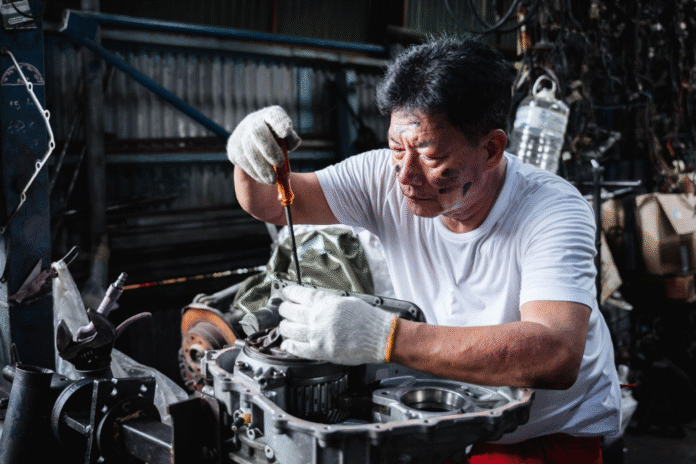Acura’s transmission development has consistently reflected the luxury division’s commitment to refined performance and technological innovation. Since its inception in 1986, Acura has distinguished itself through sophisticated transmission technologies that balance smooth operation with responsive performance characteristics, establishing a reputation for engineering excellence that continues to influence modern automotive design.
The Birth of Acura’s Transmission Philosophy
When Honda launched Acura as its luxury division, the company recognized that transmissions would play a crucial role in differentiating the premium brand from its mainstream Honda counterpart. Acura transmissions were designed to provide a more refined driving experience while maintaining Honda’s renowned reliability and performance capabilities.
Early Acura vehicles featured transmissions specifically calibrated for luxury vehicle applications, with shift programming that prioritized smoothness over aggressive performance. These early units established Acura’s reputation for producing transmissions that delivered power seamlessly while maintaining exceptional refinement levels.
The integration of advanced electronic controls in early Acura transmissions demonstrated the brand’s commitment to technological leadership. These systems provided more sophisticated shift scheduling and adaptive capabilities than were typical in the luxury segment during the late 1980s.
Manual Transmission Excellence
Acura’s manual transmissions have been particularly celebrated among driving enthusiasts, combining precise shifting characteristics with robust construction suitable for performance applications. The transmissions used in vehicles like the Integra and NSX showcased Acura’s ability to create units that satisfied both enthusiasts and luxury buyers.
The legendary NSX manual transmission represented the pinnacle of Acura’s manual transmission development, featuring a lightweight aluminum case, precise gear ratios, and exceptional refinement. This transmission demonstrated that manual gearboxes could provide both exotic car performance and everyday usability.
Close-ratio gear sets in Acura performance applications allowed engines to operate within their optimal power bands more effectively. These carefully selected ratios enhanced acceleration performance while maintaining reasonable cruising characteristics for daily driving applications.
Automatic Transmission Innovation
Acura’s automatic transmission development has consistently pushed technological boundaries, incorporating features that later became industry standards. Early adoption of electronic control systems allowed Acura automatics to provide more sophisticated shift patterns and adaptive learning capabilities than competing luxury vehicles.
The development of Acura’s sequential manual transmission technology demonstrated the brand’s commitment to providing engaging driving experiences in automatic applications. These systems allowed drivers to manually control gear selection while retaining the convenience of automatic operation when desired.
Advanced torque converter designs in Acura automatics optimized efficiency while maintaining smooth power delivery. These components featured sophisticated lockup strategies that improved fuel economy without compromising refinement or performance characteristics.
All-Wheel Drive Integration
Acura’s Super Handling All-Wheel Drive (SH-AWD) system represents one of the most sophisticated drivetrain technologies ever developed, seamlessly integrating transmission and differential functions to enhance both performance and handling characteristics. This system demonstrates Acura’s engineering capabilities in complex drivetrain applications.
The transmission components within SH-AWD systems must operate under varying load conditions while maintaining precise control over power distribution. These requirements demanded exceptional durability and sophisticated control algorithms that continuously optimize performance based on driving conditions.
Integration challenges in all-wheel drive applications required innovative solutions for packaging, cooling, and control system coordination. Acura’s engineers successfully addressed these challenges while maintaining the refinement and reliability expected from luxury vehicles.
Performance Applications and Type S Heritage
Acura’s Type S performance variants have historically featured transmission modifications that enhance performance while maintaining reliability and refinement. These applications often include modified shift programming, strengthened components, and enhanced cooling systems to handle increased performance demands.
The transmission calibrations in Type S vehicles typically feature more aggressive shift points and reduced shift times while maintaining smooth operation during normal driving. This balance between performance and refinement exemplifies Acura’s approach to luxury performance vehicle development.
Performance transmission applications often require specialized maintenance procedures and component specifications. Acura’s commitment to supporting these applications through genuine parts availability and technical expertise ensures long-term performance and reliability.
Hybrid Transmission Technology
Acura’s hybrid transmission systems represent sophisticated integration of electric motor assistance with traditional internal combustion powertrains. The Sport Hybrid SH-AWD system demonstrates particularly advanced engineering in combining multiple power sources seamlessly.
The planetary gear systems used in Acura hybrids allow for complex power routing between gasoline engines, electric motors, and drive wheels. These systems require precise control algorithms and robust mechanical components to operate reliably under varying power demands.
Battery integration and regenerative braking systems add complexity to hybrid transmission applications while providing efficiency benefits. Acura’s implementation of these technologies maintains the brand’s emphasis on performance and refinement while improving environmental credentials.
Maintenance and Reliability Considerations
Acura transmissions have earned excellent reliability reputations through careful attention to component quality, fluid specifications, and maintenance requirements. Proper service intervals and genuine fluid specifications contribute significantly to transmission longevity and performance retention.
The availability of genuine Acura transmission components ensures that proper repairs and maintenance can be performed throughout the vehicle’s service life. This parts support, combined with technical training for service technicians, maintains Acura’s reputation for long-term reliability.
Advanced diagnostic capabilities in modern Acura transmissions allow for precise troubleshooting and maintenance scheduling. These systems can identify potential issues before they become major problems, supporting preventive maintenance approaches that extend transmission life.
Aftermarket and Enthusiast Applications
The popularity of Acura vehicles among performance enthusiasts has created strong aftermarket support for transmission upgrades and replacement components. Many enthusiasts seek used JDM Acura transmission options that may offer different specifications or enhanced performance characteristics.
Performance modifications for Acura transmissions often focus on improved shift speeds, enhanced cooling systems, and strengthened components for increased power handling. The robust basic design of Acura transmissions generally accommodates these modifications well when properly implemented.
The interchange compatibility between various Acura transmission models creates opportunities for enthusiasts to upgrade their vehicles with transmissions from higher-performance applications. This compatibility supports both restoration projects and performance upgrades for older Acura vehicles.
Racing and Competition Heritage
Acura’s involvement in professional racing has provided valuable development experience that influences production transmission design. Competition applications often require modifications that demonstrate the potential of Acura transmission architecture under extreme conditions.
The success of Acura vehicles in various racing series has enhanced the brand’s performance reputation and contributed to aftermarket development investment. Racing success translates directly into consumer confidence and enthusiast interest in Acura transmission technology.
Competition experience has influenced production transmission features like enhanced cooling systems, strengthened components, and improved shift programming. These racing-derived improvements benefit all Acura customers by enhancing reliability and performance in street applications.
Future Transmission Technologies
Acura’s current transmission development focuses on integrating advanced electrification technologies while maintaining the performance and refinement characteristics that define the brand. Future systems promise even greater efficiency and performance through sophisticated hybrid integration.
The evolution toward more advanced all-wheel drive systems will likely require continued transmission innovation to manage increasingly complex power distribution requirements. Acura’s engineering expertise positions the brand well for these future challenges.
Continued investment in transmission technology development ensures that Acura will maintain its reputation for sophisticated, reliable, and performance-oriented drivetrain systems as automotive technology continues evolving toward electrification and autonomous driving capabilities.

